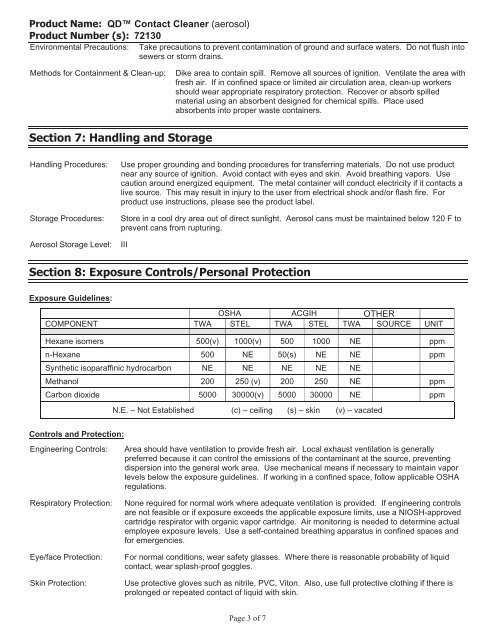Print MSDS - Miller Electric Company Publications
Print MSDS - Miller Electric Company Publications
Print MSDS - Miller Electric Company Publications
You also want an ePaper? Increase the reach of your titles
YUMPU automatically turns print PDFs into web optimized ePapers that Google loves.
QD Contact Cleaner (aerosol)<br />
72130<br />
Environmental Precautions: Take precautions to prevent contamination of ground and surface waters. Do not flush into<br />
sewers or storm drains.<br />
Methods for Containment & Clean-up: Dike area to contain spill. Remove all sources of ignition. Ventilate the area with<br />
fresh air. If in confined space or limited air circulation area, clean-up workers<br />
should wear appropriate respiratory protection. Recover or absorb spilled<br />
material using an absorbent designed for chemical spills. Place used<br />
absorbents into proper waste containers.<br />
<br />
Handling Procedures: Use proper grounding and bonding procedures for transferring materials. Do not use product<br />
near any source of ignition. Avoid contact with eyes and skin. Avoid breathing vapors. Use<br />
caution around energized equipment. The metal container will conduct electricity if it contacts a<br />
live source. This may result in injury to the user from electrical shock and/or flash fire. For<br />
product use instructions, please see the product label.<br />
Storage Procedures: Store in a cool dry area out of direct sunlight. Aerosol cans must be maintained below 120 F to<br />
prevent cans from rupturing.<br />
Aerosol Storage Level: III<br />
<br />
Exposure Guidelines:<br />
OSHA ACGIH OTHER<br />
COMPONENT TWA STEL TWA STEL TWA SOURCE UNIT<br />
Hexane isomers 500(v) 1000(v) 500 1000 NE ppm<br />
n-Hexane 500 NE 50(s) NE NE ppm<br />
Synthetic isoparaffinic hydrocarbon NE NE NE NE NE<br />
Methanol 200 250 (v) 200 250 NE ppm<br />
Carbon dioxide 5000 30000(v) 5000 30000 NE ppm<br />
Controls and Protection:<br />
N.E. – Not Established (c) – ceiling (s) – skin (v) – vacated<br />
Engineering Controls: Area should have ventilation to provide fresh air. Local exhaust ventilation is generally<br />
preferred because it can control the emissions of the contaminant at the source, preventing<br />
dispersion into the general work area. Use mechanical means if necessary to maintain vapor<br />
levels below the exposure guidelines. If working in a confined space, follow applicable OSHA<br />
regulations.<br />
Respiratory Protection: None required for normal work where adequate ventilation is provided. If engineering controls<br />
are not feasible or if exposure exceeds the applicable exposure limits, use a NIOSH-approved<br />
cartridge respirator with organic vapor cartridge. Air monitoring is needed to determine actual<br />
employee exposure levels. Use a self-contained breathing apparatus in confined spaces and<br />
for emergencies.<br />
Eye/face Protection: For normal conditions, wear safety glasses. Where there is reasonable probability of liquid<br />
contact, wear splash-proof goggles.<br />
Skin Protection: Use protective gloves such as nitrile, PVC, Viton. Also, use full protective clothing if there is<br />
prolonged or repeated contact of liquid with skin.<br />
Page 3 of 7



